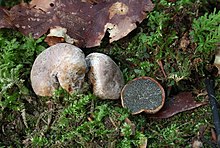
The Russulales are an order of the Agaricomycetes,. According to the Dictionary of the Fungi, the order consists of 12 families, 80 genera, and 1767 species. According to Species Fungorum, the order contains 13 families, 117 genera, and 3,060 species.
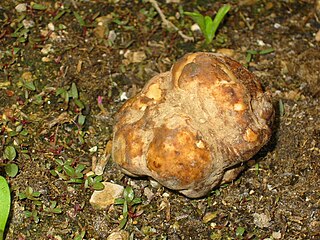
Terfezia is a genus of truffle-like fungi within the Pezizaceae family. Terfezia species are commonly known as desert truffles. Some authorities consider this the type genus of the family Terfeziaceae, although phylogenetic analysis suggests that it nests within the Pezizaceae. The Dictionary of the Fungi suggests that the genus contains 12 species. A recent (2011) publication used molecular analysis to show that the American Terfezia species had been incorrectly classified, and moved Terfezia spinosa and Terfezia longii to Mattirolomyces and Stouffera, respectively; as a result, no Terfezia species are known to exist in North America.

Genea is a genus of truffle-like fungi in the family Pyronemataceae. There are about 32 species in the genus that occur in North America and Europe. The genus was circumscribed by Italian mycologist Carlo Vittadini in 1831.

Geopyxis is a genus of fungi in the family Pyronemataceae. The genus has a widespread distribution. Molecular phylogenetic studies published in 2007 suggest that the genus is not monophyletic.

Bisporella is a genus of fungi in the family Helotiaceae. As of March 2022, the nomenclatural database Index Fungorum lists 31 species in the genus.

Nectriopsis is a genus of fungi in the class Sordariomycetes. The number of species in this genus varies between sources. The Dictionary of Fungi lists only 58 species, but the Catalogue of Life includes 72 species.

Cystolepiota is a genus of mushroom-forming fungi in the family Agaricaceae.

Merulius is a genus of poroid fungi in the family Meruliaceae. As of October 2017, Index Fungorum accepts two species in Merulius: M. debriscola, and the type, M. tremellosus.
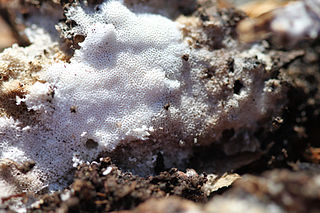
Cinereomyces is a genus of resupinate (crust-like) fungi in the family Gelatoporiaceae. The genus was circumscribed by Swiss mycologist Walter Jülich in 1981. Species in the genus have a gray pore surface except for a whitish margin, and skeletal hyphae with gelatinized walls. As of June 2017, Index Fungorum accepts two species of Cinereomyces: the type, C. lindbladii, and C. dilutabilis. The latter species was transferred to Cinereomyces from Diplomitoporus in 2016.

Hapalopilus is a genus of poroid fungi in the family Polyporaceae. The genus is widely distributed. The generic name combines the Ancient Greek words ἁπαλός ("tender") and πιλος ("cap"). Hapalopilus was circumscribed by Finnish mycologist Petter Adolf Karsten in 1881.

Lenzites is a widespread genus of wood-decay fungi in the family Polyporaceae. It was circumscribed by Elias Magnus Fries in 1835. The generic name honours German naturalist Harald Othmar Lenz (1798–1870).
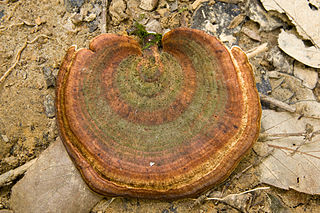
Microporus is a genus of fungi in the family Polyporaceae. The genus has a widespread distribution and, according to a 2008 estimate, contains 11 species. The genus name combines the Ancient Greek words μικρός ("small") and πόρος ("pore").

Dichostereum is a genus of corticioid fungi in the Lachnocladiaceae family. The genus contains 13 species that have a widespread distribution.

Otidea is a genus of fungi in the family Pyronemataceae. The genus is widely distributed in northern temperate regions.

Trappea is a genus of truffle-like fungi in the Trappeaceae family. Species of Trappea have been found in China, Europe, and North America.

Leucangium is a genus of ascomycete fungi. The genus was circumscribed by French mycologist Lucien Quélet in 1883. Although classified in the Helvellaceae in the past, molecular analysis indicates it is closely related to the genus Fischerula and Imaia, and therefore must be placed in the Morchellaceae. The genus includes two species, Leucangium ophthalmosporum Quél. and L. carthusianum Paol., and both of them produce sequestrate ascoma, globose to ellipsoidal ascus, and dark olive-colored to grayish green, smooth, fusiform ascospores.

Octaviania is a genus of truffle-like fungi in the family Boletaceae. The widespread genus is estimated to contain 15 species.
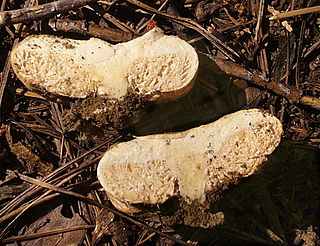
Arcangeliella is a genus of gasteroid fungi in the family Russulaceae. Taxonomic and phylogenetic research has shown that it is very likely a synonym of Lactarius. The type species Arcangeliella borziana was moved to Lactarius in 2003. However, the genus name is still in use for several species for which new combinations have not yet been proposed.
Hysterangium bonobo is a species of fungus found in the Democratic Republic of the Congo. Also known as simbokilo, the truffle-like species is named for bonobos, one of the species known to eat the fruiting bodies.
